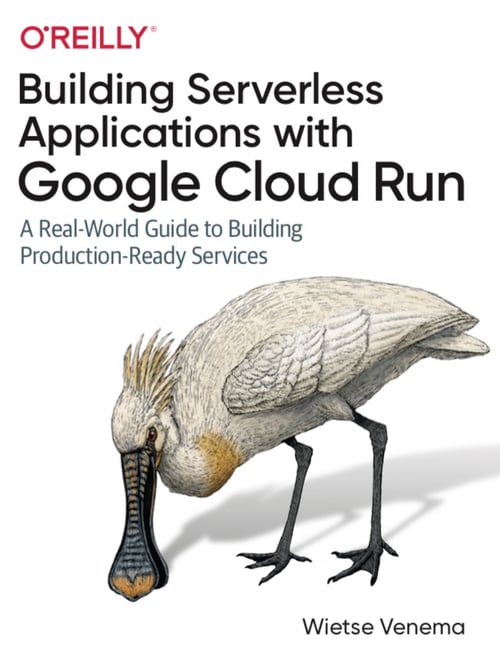Xebia Software Engineer & Trainer Wietse Venema Writes His First Book
With Google Cloud Run set to be the most interesting cloud compute platform for developers in the years ahead, Wietse Venema‘s first book could be the ideal way to learn it. As any good software engineer knows, perfection arrives through a process of endless iterations. Wietse, a senior Google Cloud engineer at Xebia, understands this intuitively. However, when he pitched his idea for a Cloud Run book to O’Reilly publishers, the novice author had no idea just how “endless” the iteration process would feel when it came to actually write it.

Read on for a freewheeling chat with our resident expert on the container-based serverless platform.
“I have a graveyard of text—almost as many pages as finally made it into the book,” he laughs, describing the hundreds of words he killed off to finish the first draft. “You become your own greatest critic, writing all day and then deleting everything in the evening, only to start again the next morning.”
First or not, authoring a book is never easy—or even absolutely achievable—but even with that understanding, Xebia supported Wietse in the endeavor. He recalls, “It’s easy to say you support dreaming big and chasing moonshot goals, but words don’t have meaning without action.” Xebia made sure he could also spend time on the project during otherwise billable work hours.
“I feel grateful for the trust Xebia placed in me,” he says. In addition to the overarching company support, he felt cheered on by his colleagues. Whenever he ran into technical issues, he turned to them for advice. “My colleagues unstuck me every time,” he grins, “especially Mark van Holsteijn.
Although he isn’t a natural writer, Wietse used a basic problem-solving approach to the process of penning his first book: if at first, you don’t succeed, try a few more times for statistical due process—and get great feedback from the best. In his book’s case, that feedback came in the form of O’Reilly’s expert editorial team, engineers and product managers at Google Cloud, and one of the founders of the Kubernetes project.
“Without their help, I would have seriously considered throwing in the towel,” Wietse says. Instead, he persevered through his process to arrive at a different result.
While working as a consultant at Xebia, Wietse has done stints with ING Bank, the franchise firm Intergamma and Nico.lab, a company that builds Strokeviewer—an AI-powered product that helps stroke patients get the right life-saving treatment in minutes. Drawing on his own knowledge and expertise, he has also designed and facilitated customized on-the-job training for different teams at the Dutch payment industry pioneer Mollie.
Given that background, readers can expect a book that dives right into the technical deep end but also stays grounded in realistic scenarios. “People know me as the kind of guy who finds the unexpected, clear solution to a problem,” he says. You can find that same kind of creative tenacity and Wietse’s effortless, “keep-it-simple approach” throughout his book’s pages.
That book is Building Serverless Applications with Google Cloud Run (full chapter outline here). Two years in the making, the book is a clear and understandable instruction manual to assembling production-ready services on the container-based serverless platform. Issued by leading tech publisher O’Reilly, complete with trademark animal cover, Wietse’s book will be released in the run-up to Christmas, in a suitably “coronappropriate” launch. “So it’ll be me in a Zoom meeting,” he laughs.
A practical guide to constructing reliable, secure, maintainable, and scalable real-world applications, the book came about because Wietse felt there was a real need.
“Cloud Run is all about productivity. As a developer, I like to think about the code I’m writing and have the platform worry about the lower-level infrastructure problems that eat into your development time. I don’t want to be concerned with upgrading operating system packages and configuring HTTP proxies; I want to focus on building a great application that performs and that’s reliable and secure. And I wanted to help other developers do the same,” he explains.
Chapter by chapter, Wietse takes readers through a number of topics that are essential when building a serverless application on Cloud Run; understanding what containers do and how to build container images, connecting your application to managed relational databases and private IPs, as well as explaining portability to other vendors using Knative Serving. Anyone with experience in building traditional web applications will be able to follow the hands-on lessons to get a start on serverless containers.
Now, having put himself through the wringer once with this debut book, Wietse is ready to take his interest in writing further. He’s been approached to write content for the Google Cloud blog (his guest post will be published sometime next week), and he’s currently working on a training course centered around Cloud Run. A new blog is also in the works and another book idea is brewing. “I might like writing almost as much as my day job,” he smiles. Fortunately, for Xebia and our clients, his core passion remains for the cloud.





